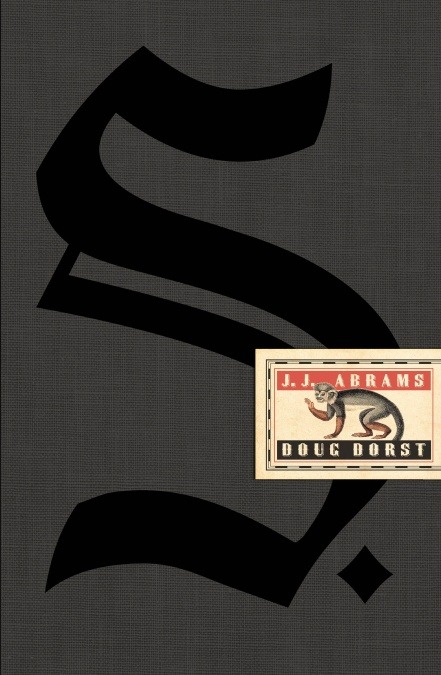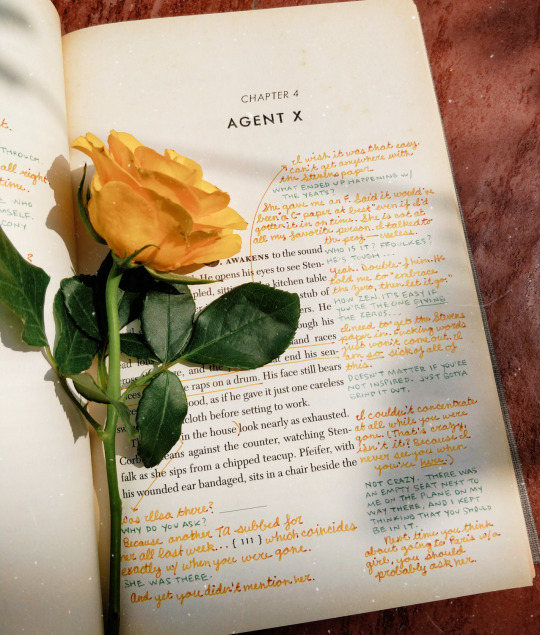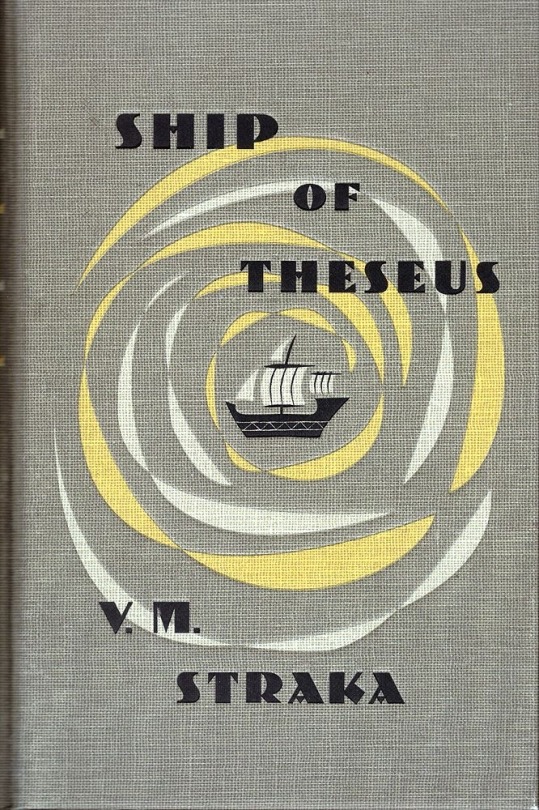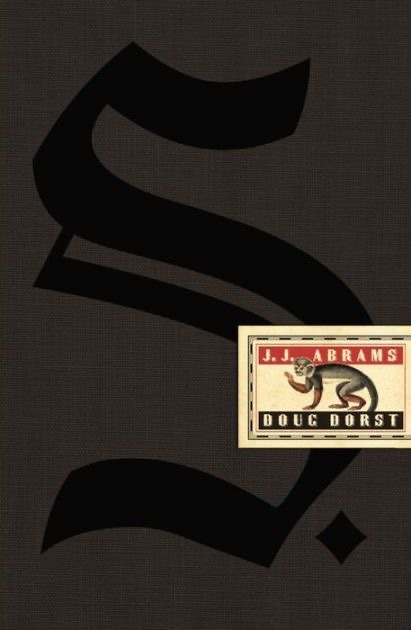#V.M. Straka
Text
has anybody else read house of leaves by mark z. danielewski or s by doug durst/jj abrams? if so i would love to talk to you
#house of leaves#mark z. danielewski#the navidson record#zampanó#johnny truant#s#doug durst#jj abrams#ship of theseus#v.m. straka
40 notes
·
View notes
Text
Started reading S. by Doug Dorst and J.J. Abrams and idk if its the ADHD talking but I think it's way more accessible than House of Leaves honestly. That's not to say that HoL is bad, just that it can be a HORRIBLE slog to get through at times with its academic language and large swaths of repetitive text. It is by no doubt a very good book, but I've had it for over a year and have sadly not been able to finish it yet.
S. On the other hand, engages with the reader more easily with how the 2 other readers leaving notes are fairly down to earth and informal, making it an easier read imo. That doesn't mean it takes any less time for me to get through however, because the way I've chosen to read it is to read all the typed out text in a single chapter first and then go back and read the notes and extras. Maybe it'd be even easier for someone who reads more books regularly but I haven't been able to do that in a long time so :/
#S. (ADHD) vs. House of Leaves (autism)#/hj#i mourn the time i could read 500 pages a day#S. book#??#S. doug dorst#S. j.j. abrams#V.M. Straka
4 notes
·
View notes
Text
Eric and Jen so far are just an alternate reality version of Dash and Lily
6 notes
·
View notes
Text
01/01/2024
Day 3 of reading S by J.J. Abrams/Doug Dorst:
SPOILERS AHEAD
I've finished the actual text of the novel by V.M. Straka, which was a slog not gonna lie. It's got so much mystery to it that I find it frustrating, and it annoys me that the main character doesn't complete either of his two missions (figuring out who he was and killing Vévoda).
Wish me luck for the first wave of marginalia!
#original#mine#dark academia#literature#aesthetic#academia#books#light academia#english literature#the ship of theseus#s#jj abrams#Doug dorst#v m straka
12 notes
·
View notes
Text
Book Review: S. Ship of Theseus
Ship of Theseusby J.J. Abrams, Doug Dorst (Goodreads Author), V.M. Straka (Attributed Author)
1 out of 5 stars
This book within a book shows handwritten notes in the margins from Jen and Eric as they read the book text, speculating about the mystery surrounding the author. The main text of Ship of Theseus is the story of a man with amnesia who is shanghaied aboard a strange ship where time…

View On WordPress
0 notes
Text
The book, a living object! - part 2
I love going to book fair to find surprising books. My favorite kind is the one playing with book’s characteristics and materiality to tell a story. This liking compelled me to discover an interesting literature genre: ergodic literature. This designation was theorized by Espen J. Aarseth in Cybertext一Perspectives on ergodic literature in 1997 and describe books where the reader need to produce a “non-trivial” effort to go through the work. Indeed, for Aarseth, a trivial effort while reading a book is the simple action we do like turning the page or sweeping the page with our gaze as those actions are unconscious and do not disrupt the reading experience. On the other end, a non-trivial effort would be to have to turn around the book to follow its story or having to go back and forth with the pages like the narration codes from Choose your own adventure games.
One notable example of this genre is House of Leaves written by Mark Z. Danielewski, and it is by the means of Danielewski’s work that I discovered the book I want to present today. Simply titled S. this ergodic novel was written by Doug Dorst, starting from JJ. Abrams’s initial concept of an annotated book which could deliver a story within the story.
S. is a black box containing a book, Ship of Theseus, published in 1949 and written by V.M Straka, the most mysterious authors of the 20th century. No one knows who he is, and many want him dead because of his political underlying, as his novels have sparked many revolutions against capitalist powers.
S. looks like a library book, it has a classification tag on its spine and a return date sticker on the last flyleaf.Inside is the whole novel which is the core layer of the story. Ship of Theseus tells the story about a man who lost his memories and is kidnapped on a ship, stuck with a monstrous crew. Through this journey, he will try to uncover his memory and survive. Then the second layer of S. is F.X. Caldera, Straka’s translator. Footnotes are inhabited by Caldera’s commentary on Strakas complex ideas… The other layers are placed in the book margins. Two students talk together through the book. Jen, an undergrad student who found the book in the college library and is curious about all the mysteries around Straka’s identity and Erick, a grad student who studied the book since he was fifteen and got his thesis work on Straka stolen by his director.

A close-up view of S. with Jen and Erick handwritten notes, the novel Ship of Theseus, F.X Caldera footnotes on the bottom left and one of many ephemera, a post card.
S. Doug Dorst and JJ. Abrams, 2013, Mulholland Books.
This narrative construction is a prime example of the utilization of metatextuality to showcase the rhizomatic nature of books. Precisely, S. even transcend this with the addition of transmediality to his diégèse* but first, I will address the case of metatextuality.In this novel, every element of content is implemented to establish a game of make believe as to give an thrilling adventure for the reader. Doug Dorst, the author, started by writing the entirety of The Ship of Theseus so Straka’s work appeared as an actually good book worth analyzing, then the annotation came along. As a reader, seeing the metatextual conversation of Jen and Erick convey a sense of intimacy and offer a new perspective on Straka’s mystery.The characters ubiquity thanks to the multiple temporalities and the multiple ephemera and encrypted codes give the reader all the tools to partake himself, in the solving of S. On one hand, it will encourage the reader to also write their clues and researches in the margins and on the other hand, the reader becomes part of the diégèse as The Ship of Theseus and Straka’s work is supposed to be part of our world. This experience and this blurred definition of authorship with the reader highlight the rhizomatic and living connection this book produces. Yet the last stretch this work holds is his transmediality and how it makes reality enter its diégèse and showcase its living system. In fact, the internet has disrupted quite a lot of the way artworks are perceived and interacted with. For the case of S. official forum where created to expand the book universe like some people had made a website dedicated to Straka’s work, yet readers have met there and started to discuss the mysteries of The Ship of Theseus, sharing their clues like Jen and Erick were doing! Many other creations around S. were made and as they used the book elements to talk about his mystery we can say that they are allowed into S. diégèse and are canon thus reality colliding into fiction and placing this story as a (maybe) never-ending system…
At last, I would like to reflect S. metatextuality through the lens of type design. In the original english version, “handwriting actors” were hired to give specific handwriting to Jen and Erick. This process can seem too much because of the time it takes yet its effect is powerful. This really exploits the strength and subtlety that are inherent to calligraphy. With S. story, this greatly participates in the feeling of intimacy the reader obtains and helps his dispensation of disbelief.

Detail from the french edition showacasing the script fonts choosed for the characters. The cursive one is for Jen and all caps one is for Erick.
The place in the margins of Jen and Erick's commentary is already enough for the reader to assume that within this universe, those are supposed to be real people writing notes to each other. In this manner, the use of a script type is absurd and doubting the reader's intelligence. In the initial publication of S., the handwriting participates in the game of narrative and material makes belief in the book it builds upon. As previously explained, it blurs the boundary between fiction and nonfiction mimicking what the reader could do. On the other hand, the french version uses Script typefaces…They most likely wanted to cut costs and work faster while keeping the idea of written footnotes yet those are nothing but a dealbreaker. Script typefaces already tend to look horrendous as they are very stiff and systematic which is the opposite of an actual handwriting. It makes them look uncanny and ironically more unnatural than other kinds of typefaces. Moreover they disrupt the sense of intimacy and narrative metatextuality S. deliver as it delivers cheap looking notes and by that give place for this whole process to seem like a gimmick and not an actual thoughtful narrative experience. I am convinced that a more industrial approach can be properly done simply by using typefaces that are not from the script family, but are reminiscent of the Jen and Erick personality. For example, Erick has a more stiff and nerdish communication style thus a type like IBM Plex Sans which encompasses a geometric and computer,library feeling would fit him. For Jen, as she is more snarky and cheerful yet, write delicately, a dynamic yet robust type like the Swift by Gerard Unger would be, in my humble opinion, a good fit!

IBM Plex Sans Type designed by Mike Abbink, Paul van der Laan & Pieter van Rosmalen for IBM in 2018.

Swift Type designed by Gerard Unger in 1989 for Linotype.
In conclusion, S. is a fascinating work to better feel and see how metatextuality and transmediality can be a wonderful creative tool for narration. Especially as a graphic designer, it is crucial to keep an eye on those kinds of literary projects that are able to efficiently subvert ways of reading thanks to thoughtful book design and to be wary of dubious type choices…
*diégèse is a term coined by Gérard Genette and describes the spatiotemporal universe encompassed in the story and how it is defined. What is part of the diégèse does not have to be explicitly written about in the story but rather to follow the rule of this universe.
5247 signs
Additional content:
S. video trailer to promote the story (38) S. (From J.J. Abrams and Doug Dorst - Bad Robot Productions) - YouTube
S. book trailer S. El barco de Teseo - J. J. Abrams & Doug Dorst | Booktrailer - YouTube
Doug Dorst and J.J. Abrams speech about the creation of S., 2014
J.J. Abrams & Doug Dorst Interview on S. | A Multi-Layered Book Experience - YouTube
Côme Martin speech Transmédialité et interactivité : de l'objet-livre à la fiction rhizomatique at l'ESAD, 2015 Côme Martin — Textures de l’objet livre 2015 on Vimeo
1 note
·
View note
Text

S. El barco de Teseo de JJ Abrams | Libro Resumen
"S. El barco de Teseo", de J.J. Abrams y Doug Dorst, es una novela que revoluciona el formato tradicional. La trama principal sigue a S., un hombre amnésico en un barco misterioso, enfrentándose a fuerzas oscuras mientras descubre secretos sobre su identidad. En paralelo, en los márgenes del libro, los estudiantes Jen y Eric desentrañan los misterios del autor ficticio V.M. Straka. Este diseño innovador del libro, con materiales insertados como postales y mapas, enriquece la experiencia de lectura. Los temas de identidad, realidad y literatura se entrelazan, presentando la obra como una metaficción y un rompecabezas. "S. El barco de Teseo" es una experiencia de lectura única, combinando misterio y diseño literario innovador.
youtube
0 notes
Photo

Title: S.
Author: J.J. Abrams, Doug Dorst
Series or standalone: standalone
Publication year: 2013
Genres: fiction, mystery, fantasy, thriller, contemporary, romance
Blurb: A young woman picks up a book left behind by a stranger. Inside of it are his margin notes, which reveal a reader entranced by the story and by its mysterious author. She responds with notes of her own, leaving the book for the stranger...and so begins an unlikely conversation that plunges them both into the unknown. Ship of Theseus is the final novel by prolific but enigmatic writer V.M. Straka, in which a man with no past is shanghaied onto a strange ship with a monstrous crew and launched onto a disorienting and perilous journey. Straka is the incendiary and secretive subject of one of the world’s greatest mysteries, a revolutionary about whom the world knows nothing apart from the words he wrote and the rumours that swirl around him. Jennifer and Eric are a college senior and a disgraced grad student, both facing crucial decisions about who they are, who they might become...and how much they’re willing to trust another person with their passions, hurts, and fears.
#s#s.#jj abrams#j j abrams#doug dorst#standalone#2013#fiction#mystery#fantasy#thriller#contemporary#romance
1 note
·
View note
Text
S. - J.J. Abrams, Doug Dorst

A book where the story really is told in the margins.
This story within a story novel is my favourite book. The book itself "Ship of Theseus" written by fictional, in-universe author V.M. Straka is a tale of a man shanghaied away onto a ship, where his life drastically takes a turn, as he discovers himself and his fate. However the second story, or the "main story" we find written within the margins of the book, taking the form of notes written between two people as they return and take out the book from their university library. This story is about Eric, a student studying Straka, and Jen, who picked up the book to read herself. Eric is trying to uncover the real identity of the fictional Straka, whilst Jen is trying to decide what her next step in life will be. The book itself contains multiple inserts, such as news clippings, letters, and postcards, that Eric and Jen have shared back and forth between themselves. These all add such depth to the story, and really help to immerse the reader within the world of the novel.
This wonderfully unique concept allows for two simultaneous stories, the story of Eric and Jen, and the story told by the fictional V.M. Straka of The Ship of Theseus.
0 notes
Text

Shelf-Confidence Book Photo Challenge
January 19, 2022 - Notes in the Margins
This book comes with notes all over the pages, as a way for the two characters to talk to each other.
#shelfconfidencebpc#s.#j.j. abrams#doug dorst#the ship of theseus#v.m. straka#booklr#mypics#books#books and flowers#bookblr#tbr
106 notes
·
View notes
Text
“One person’s audacity: the only prerequisite for resistance.” - V.M. Straka
6 notes
·
View notes
Text
"What Begins, What Ends" Theory/Observation
“What Begins At The Water Shall End There, And What Ends There Shall Once More Begin”
Which corresponds to how every time we reach the END of the book(“What Begins, What Ends”, we go back to the BEGINNING of the book to read the next set of footnotes, so it “Once More Begins”.
Maybe that’s why the footnotes start at the beginning again when we get to end instead of just reaching the end of the book.
5 notes
·
View notes
Text
"When he reopens his eyes, the constellations are no longer even recognizable. A spray of light-points no longer organized by the shapes mankind has traced over them for thousands of years. They wink, they tremble, and he swears he can see them drift-- as one might be able to see the minute hand of a clock moving. He is a man without a past sailing in a strange sea in a world where the stars have come loose in the firmament."
- V.M. Straka, Ship of Theseus
12 notes
·
View notes
Text
I desperately need to talk to someone who is both a fan of “Dash and Lily” and S. by J.J. Abrams and Doug Dorst. I am connecting the two in my head and I desperately need to talk to someone that would get me
#also#i need to annotate back in forth in a book with someone#in a platonic way to be clear#dash and lily#s JJ abrams#v.m. straka#straka
2 notes
·
View notes
Text
I bought this book that's like a story within a story... I's called "S", and it's the book "Ship of Theseus" by V.M Straka, but the other story is in the margins between two people who are checking it out of the library to read it and are communicating with each other in the margins, and there are also inserts like postcards and napkins and notes that they leave for each other. And in the back of the book there's a decode wheel thing.
and anyway, the story in the margins thing was conceived by JJ Abrams and written by Doug Dorst.
I'm super excited to read it.
4 notes
·
View notes
Text
S.


4.5/5
-I would definitely recommend this book! It was such a fun and immersive read, but it was a bit pricey: $45 from Barnes and Noble.
Summary: Senior college student Jennifer picks up a copy of Ship of Theseus by V.M. Straka from the college library and decides to write to the owner to say how much she loved the story. Eric, an expunged student from the college, writes back which starts a relationship between the two in the margins. Ship of Theseus is about a character named S. who doesn't have a past and is having to learn about himself and the world around him. He gets kidnapped by sailors shortly after meeting a girl named Sola when his journey begins. It's a lovely story about self discovery and love.
The annotations are done by Jen and Eric at different times like the black and blue is done in the beginning, orange and green later, purple and red after that, and finally black ink. There are several clues in the book like Xeroxes, letters, postcards, and a map drawn on a napkin; it's really easy to become immersed in the story.
Trigger Warning: violence, death, blood, fire, needles
Warning! There are spoilers lurking beyond the "keep reading!"
-When Eric wrote that he loved Jen. Bruh go ahead and put that on the list of things to daydream about: a person developing between the margins of a book solving a mystery, and they confess their love for me. We meet up in person for the first time, and I say my feelings for them, not in ink but in spoken words. We then move to Europe and work as scholars.
-When Eric wrote that he loved Jen. Bruh go ahead and put that on the list of things to daydream about: a person developing between the margins of a book solving a mystery, and they confess their love for me. We meet up in person for the first time, and I say my feelings for them, not in ink but in spoken words. We then move to Europe and work as scholars.
-I loved when S. and Sola finally got to work together and how trippy time was. Like the different versions of themselves and how time went at a different pace on the ship.
Quotes:
-"What begins at the water must end there, and what ends there shall once more begin."
-"It's extremely cool how the words can stay the same but the meanings can change.
Because the reader changes."
-"Words are a gift to the dead, and a warning to the living."
"Of course there is a monkey. There is always a monkey." This is in reference to a monkey consistently showing up in the scenes.
Overall this book was worth the $45. It was a fun and interesting read that made me experience again how fun interactive books are; it kind of reminded me of going to the library when I was in elementary school and looking at the fun pop-up books or the ones with letters and extra post cards. I love the characters- both in the margins and in the text- and how their stories are told.
7 notes
·
View notes